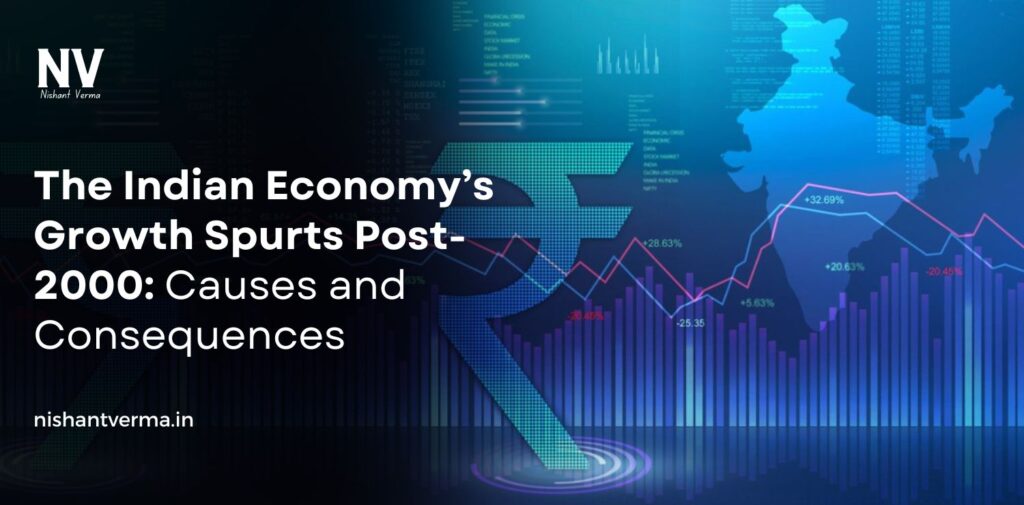India, one of the world’s largest and most dynamic economies, has experienced remarkable growth since the turn of the 21st century. This period has seen the country transition from a somewhat stagnant economy to one of the fastest-growing economies globally. The growth spurts India experienced post-2000 have been driven by several factors, and the consequences of this rapid expansion have been both positive and challenging. This article will explore the reasons behind Indian Economy Growth Spurts , its significant impacts, and the challenges the country faces as it continues to develop.
Economic Liberalization and Reforms
The roots of India’s post-2000 economic growth can be traced back to the 1991 economic reforms, which opened up the economy to global markets. However, the period after 2000 saw the acceleration of these reforms, allowing India to become a key player in the global economy. The liberalization policies of the 1990s, which included reducing trade barriers, privatizing state-owned enterprises, and encouraging foreign investment, set the stage for significant growth.
Post-2000, India’s services sector became a major contributor to economic expansion. The IT and software services industries, in particular, saw massive growth as global companies began outsourcing jobs to India, where labor was cheaper and skilled workers were abundant. The rise of global tech giants, such as Infosys, Wipro, and Tata Consultancy Services, demonstrated India’s strength in the technology sector. This influx of foreign capital and technology led to a digital revolution that transformed the economy.
Additionally, the Indian government took steps to improve infrastructure, such as roads, ports, and airports, which facilitated both domestic and international trade. The gradual reduction in inflation and the focus on fiscal discipline provided further stability for growth, making India a more attractive destination for foreign direct investment (FDI).

Demographic Dividend and a Young Workforce
Another significant factor behind India’s economic growth is its demographic profile. India has one of the youngest populations in the world, with a large portion of the population being in the working-age group. This “demographic dividend” has played a crucial role in driving economic growth.
The young workforce has provided a vast labor pool for industries ranging from agriculture to manufacturing to services. India’s large, educated, and skilled workforce has attracted both domestic and international businesses. Furthermore, this young demographic is driving demand for consumer goods, technology, and housing, which has fueled economic growth in both urban and rural areas.
The growth of the middle class, which has expanded significantly in the last two decades, has further stimulated domestic consumption. A larger middle class means more people with purchasing power, which in turn drives the growth of sectors such as retail, real estate, and automobiles. This rising affluence has been a key factor in India’s economic success.
Expansion of the Services Sector
The most noticeable and important growth spurt in India’s economy post-2000 has been in the services sector. While traditional industries such as agriculture and manufacturing have played a role, it is the services sector that has been the driving force behind India’s economic transformation. The IT and Business Process Outsourcing (BPO) industries were at the forefront of this growth.
With companies like Infosys, Tata Consultancy Services, and Wipro leading the charge, India became the global hub for outsourcing services. The demand for IT solutions, software development, and customer support led to a sharp increase in India’s GDP contribution from the services sector. In addition to IT and software, other areas such as financial services, education, healthcare, and telecommunications also saw rapid growth, contributing significantly to the economy.
The digital economy also flourished in this period, with the internet becoming more accessible, mobile connectivity improving, and e-commerce platforms like Flipkart and Amazon India rising to prominence. These developments have transformed how businesses operate and how consumers shop, leading to more growth in the services sector.

The Rise of the Indian Stock Market
The Indian stock market also witnessed significant growth after 2000. Stock market liberalization and improved investor confidence led to a boom in the Indian stock market. The Indian government introduced measures to improve transparency, corporate governance, and investor protection, which boosted domestic and international confidence in the market.
The Sensex, which tracks the performance of 30 of India’s largest companies, saw significant growth after 2000. India’s stock markets, including the National Stock Exchange (NSE) and the Bombay Stock Exchange (BSE), became increasingly integrated with global markets, providing more opportunities for investors. As foreign investors sought to take advantage of India’s growth potential, capital inflows into the Indian stock market increased, contributing to overall economic growth.
This growth in the stock market provided businesses with easier access to capital and financing, enabling them to expand operations, invest in new technologies, and create more jobs. The rise of retail investors also contributed to the growing wealth of Indian households, and the stock market became a key part of India’s economic landscape.
Infrastructure Development and Urbanization
India’s rapid economic growth has also been fueled by significant investments in infrastructure. Over the last two decades, the country has made strides in improving its infrastructure, which has played a key role in economic development. This includes developments in transportation, energy, and urbanization.
The improvement of transportation networks such as highways, railways, and airports has reduced logistical costs, making it easier for goods and services to be transported within the country and internationally. The increase in foreign investment in the infrastructure sector has led to the creation of modern airports, highways, and metro systems in major cities. This infrastructure development has allowed businesses to grow and has attracted foreign companies looking to tap into India’s growing market.
Urbanization has also been a key driver of India’s economic growth. As rural areas continue to migrate to urban centers in search of better employment opportunities, India has seen a rapid expansion of its cities. This has created new economic hubs, providing opportunities for businesses to set up in emerging markets. The rise of smart cities and the improvement of housing and commercial infrastructure have helped in creating jobs and improving the standard of living for millions.

Consequences: Economic Growth and Its Challenges
While India’s growth spurts since 2000 have brought immense benefits, they have also come with challenges. The growth has often been unequal, with urban areas benefitting more than rural regions. Income disparity has increased, and the gap between the rich and poor continues to widen. While the middle class has expanded, millions of people still live in poverty, particularly in rural parts of the country.
Moreover, the rapid expansion of industries has led to significant environmental challenges. India has faced issues like air pollution, water scarcity, and deforestation, which are becoming increasingly difficult to manage as the economy grows. The country’s dependence on coal for energy production has contributed to high levels of carbon emissions, making it harder for India to meet its environmental goals.
Additionally, job creation has not always kept pace with the growing workforce, particularly in the manufacturing and agriculture sectors. Many of the new jobs created are in the informal sector, which does not offer social security or employment benefits, leading to precarious work conditions.
Another consequence of rapid growth is the increasing pressure on infrastructure. While there have been substantial improvements, India’s infrastructure still lags behind the needs of a growing economy. Traffic congestion, lack of affordable housing, and inadequate sanitation facilities in urban centers continue to pose significant challenges.
Conclusion: Indian Economy Growth Spurts
India’s economic growth post-2000 has been one of the most remarkable stories of the 21st century. The country’s liberalization, demographic dividend, rise in the services sector, stock market growth, and infrastructure development have collectively driven the economy forward. However, the consequences of this rapid growth have also brought challenges, including inequality, environmental degradation, and infrastructure gaps.
As India continues to grow, it will need to address these challenges while maintaining the pace of development. Ensuring that the benefits of growth are shared more equitably across society and managing the environmental impacts of industrialization will be crucial for the country’s long-term economic success. Nevertheless, India’s post-2000 growth story provides valuable lessons in how developing countries can achieve sustained economic growth while navigating the complexities of a rapidly changing global landscape.




